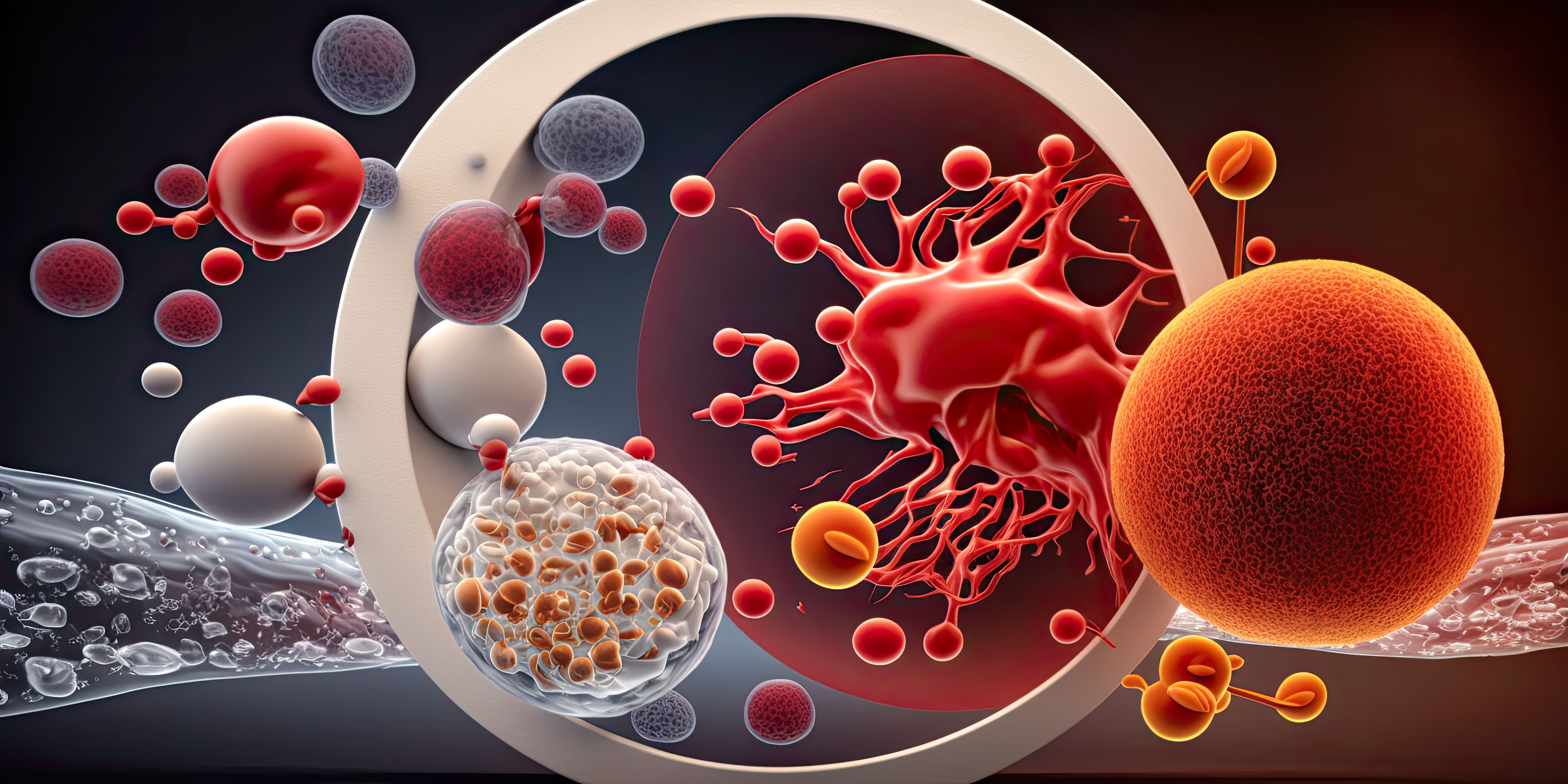- Center on Health Equity & Access
- Clinical
- Health Care Cost
- Health Care Delivery
- Insurance
- Policy
- Technology
- Value-Based Care
New Work Highlights Proteins as Potential Novel AML Therapeutic Targets
Three proteins—THRAP3, STMN1, and GNA13—are overrepresented in blood cancers like acute myeloid leukemia (AML) and could prove to be novel targets for future therapies.
Study results published in 3 Biotech indicate that 3 proteins could be addressable factors in the progression and prognosis of such blood cancers as acute myeloid leukemia (AML), diffuse large B-cell lymphoma (DLBCL), and Burkitt’s lymphoma (BL).1 Utilizing Western blotting, the author found that the proteins—THRAP3, STMN1, and GNA13—were overly expressed in these blood cancer cells, yet their presence was barely detectable in blood cells from healthy individuals.
New therapies for AML and other blood cancers may be informed by the overexpression of 3 proteins | image credit: jovannig - stock.adobe.com

Additionally, these 3 proteins had higher mRNA expression in not only blood cancers but in other malignancies, compared with matched normal tissues (P ≤ .01), which was observed using genotype-tissue expression and gene expression profiling interactive analysis. The Kaplan–Meier curve analysis indicated that the upregulated mRNA transcript expression of THRAP3, STMN1, and GNA13 was a feature of poor prognosis—like shorter overall survival (P ≤ .02)—in patients with blood cancers.
Further work could eventually confirm if and how STMN1, GNA13, and particularly THRAP3 are involved in tumorigenesis and could represent effective therapeutic targets, noted the author. In this work, THRAP3 especially emerged as a potential focus. It was associated with cancer-dependent proliferation and survival pathways (corrected P ≤ .05) as well as protein interaction (P = 1 x 10-16) implicated in tumorigenesis and chemotherapy resistance, as revealed by functional profiling and protein–protein interaction (PPI) network analysis.
Given the usual aggression of AML, DLBCL, and BL, the author’s message is that developing novel therapies is crucial. He noted that targeting STMN1 has already been shown to inhibit proliferation and metastasis of pancreatic cancer.
Previous Supported Proteomics Work
In their earlier investigation of possible links of THRAP3, STMN1, and GNA13 with chronic lymphocytic leukemia (CLL), the author and colleagues did indeed find a relationship, especially of THRAP3 with CLL.2,3 Researchers on other teams have also previously noted potential relationships between each of these proteins and blood cancers—THRAP3 and multiple myeloma, for example.
Overall, reports have shown for years that overexpression of these 3 proteins seem to have a link to rapid progression and poor prognosis in many cancer forms. Previously found, for instance, are relationships between overexpression of STMN1 with such other malignancies as gastric cancer, lung cancer, endometrial carcinoma, thyroid carcinoma, ovarian cancer, and pancreatic cancer. GNA13 was earlier discovered to be highly expressed and/or related to drug resistance in squamous cell, breast, colorectal, liver, and gastric cancers.
Profiles and Pathways
The author’s functional profiling and PPI analysis of THRAP3 found that it was significantly associated with cancer-dependent proliferation and survival pathways, such as the spliceome, hippo, alternative splicing, BCR signaling, FOXO, mTOR pathways and more. These pathways are known to drive cancer cells’ growth and survival and have been recognized previously as good targets for cancer therapy.
Specifically, the author wrote, SNRPB1 andCDCL5—found here to correlate with THRAP3—are key players in the spliceome pathway, have been implicated in tumorigenesis and cancer progression, and are considered promising therapeutic targets. Furthermore, he continued, CD79A, CD79B, PIK3CA, and AKT1—also found in his current work to correlate withTHRAP3—are key components of the BCR signaling pathway, known to drive progression of various B-cell lymphomas, and are viewed as promising therapeutic targets as well.
The author’s PPI analysis indicated that THRAP3 interacts with 43 proteins that are implicated in RNA processing, RNA splicing, and RNA synthesis. Some of these 43 have been previously implicated in tumorigenesis and chemotherapy resistance, he noted.
For instance, nuclear mediator of RNA polymerase II transcription subunit 12 activates TGF beta signaling and activates the expression of TGF beta target genes like vimentin; this promotes chemotherapy resistance and reduces the expression of the cell cycle inhibitor P16, supporting tumorigenesis. In addition, it has been found that nuclear receptor coactivator 3 drives tumorigenesis by modulating the ErbB, AKT, ERK, and β-catenin pathways. Then, it induces chemotherapy resistance by activating expression of other transcriptional factors that promote drug resistance, such as E2F-1, AP-1, NF-κB, and STAT6.
References
1. Alsagaby SA. Biological roles of THRAP3, STMN1 and GNA13 in human blood cancer cells. 3 Biotech. 2024;14(10):248. doi:10.1007/s13205-024-04093-5
2. Alsagaby SA, Khanna S, Hart KW, et al. Proteomics-based strategies to identify proteins relevant to chronic lymphocytic leukemia. J Proteome Res. 2014;13(11):5051-5062. doi:10.1021/pr5002803
3. Alsagaby SA, Brewis IA, Vijayakumar R, et al. Proteomics-based identification of cancer-associated proteins in chronic lymphocytic leukaemia. Electron J Biotechnol. 2021;52:1-12. doi:10.1016/j.ejbt.2021.04.006
